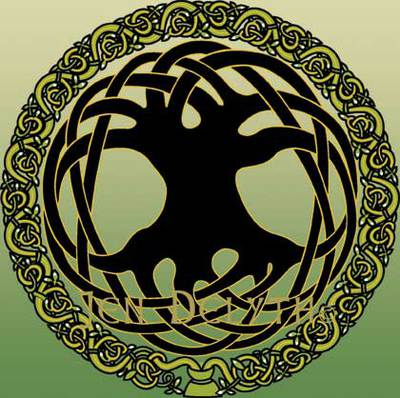Judge Wyndham’s Oak

[The Celtic Tree of Life. Source: Google search. CelticArtStudio.]
Trees are the earth’s endless effort to speak to the listening earth.
~~Tagore
A few days ago, my friend, Tim, asked me if he had ever taken me to see Judge Wyndham’s Oak. I said that I have no recollection of such a visit. He said, Let’s go then, shall we? Sure, I said.
So, off we drove, through roads narrow and menacing. Even Tim, a proper Englishman well used to lanes where the hedge-row ivy leaves banged and scraped against the car doors, said: Let’s go another way.
The showers had given way to a partly sunny afternoon, windy, fresh and vigorous. We parked in a lot adjacent to an old country church. I wanted to poke around the moldy grave stones and read the poignant epitaphs, but Tim said that we would stop at the church in a bit.
He had a tree to show me.
We passed through a gate and found ourselves in a large field populated by a flock of sheep. They stepped aside as we crossed their pasture, baaing at us every few seconds.
The tree right in front of us was grown from an acorn from the Judge’s Oak, said Tim.

[The child of Judge Wyndham’s Oak. The real tree is hidden in the distance. Photo is mine.]
We continued on our way across the field. The wind picked up and I was feeling fairly comfortable. A moment later, we came upon what looked like just another tree in just another pasture.
It was anything but.
As we approached the oak tree, I do believe I felt the weight of years in the size of the trunk, the bifurcation of the thick branches and the fact that the tree is said to be 1,000 years old! They don’t grow trees like that back home.
Technically, it is located in Silton, Dorset, and was among a number of historic oaks that marked the boundary between Selwood Forest and Gillingham Forest. It was part of a large medieval hunting ground. (Later we drove to the far end of the forest on the other side of the town of Gillingham. It was one very large hunting preserve.) We can be fairly confident about the tree’s age because the British are very meticulous about keeping records of just about everything. An important oak, used as a legal boundary, would be carefully documented.

[The 1,000 year old oak, Quercus robur. Photo is mine.]
I stood in the tree’s shadow. I put my hand among the low lying leaves. I even stepped inside the trunk. It was wired together like an old man’s back.

[If the need arose, I could have spent the night inside this old tree. I’m sure it would have stories to tell. Photo is mine.]
Tim walked off a few yards. Perhaps he knew I needed a few minutes to feel the ageing vibes from the DNA of this other old guy. I closed my eyes as I leaned against the massive trunk. I tried to tune into the ancient echoes of voices, centuries old, of other people who stood in the very spot I occupied. It’s been said that the sound waves produced by the vocal chords of human speech, never really go away…totally away. They just get more faint. But they’re still out there, somewhere. Who stood here? Who kissed a farm girl, loved a man, dreamed of happiness, cried about a loss, cried about a broken heart, cried because of crippling loneliness, the death of a wife, a husband, father, mother…one’s faith?
Who stood where I was standing. Did they think about the things I think about?
I looked over the field at the church…I saw the tops of gravestones just beyond the stonewall. Were the lovers reclining under this tree, once upon a time, so many many years ago now buried over there? I can barely see those small mounds, their graves. Does that churchyard soil cover a rotted oak coffin? Are their human remains now part of the soil, part of the groundwater, part of the transpiration that carries their molecules aloft, into the clouds and then to be rained down again to water an acorn destined to be 1,000 years old?
Some things are never meant to be answered, I suppose.



